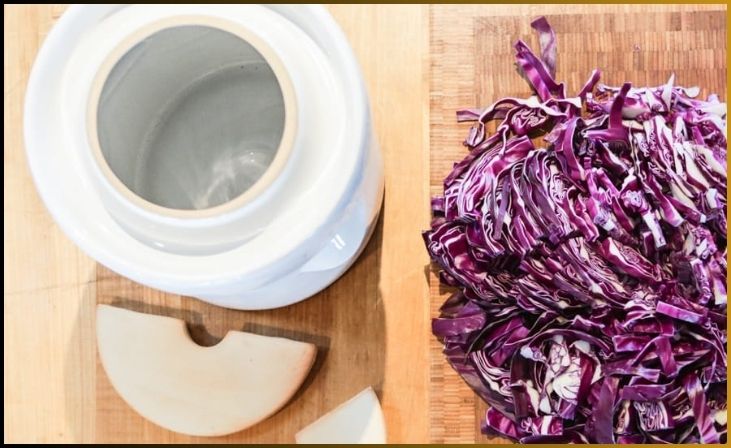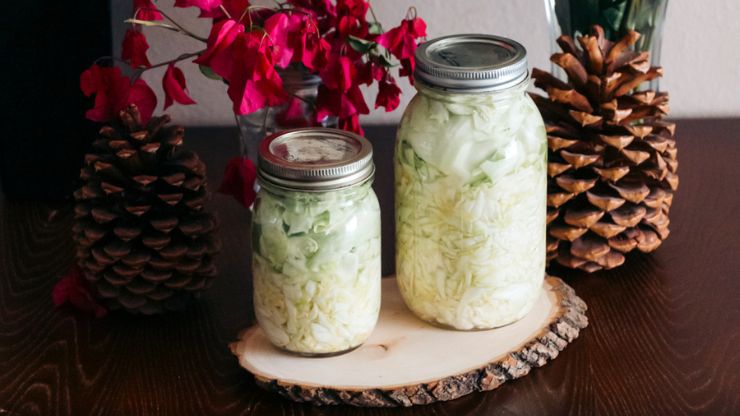The thing that excites me about fermenting foods the most, is that you can do this no matter what time of the year with whatever you have on hand. So, if it’s late fall, ferment apples or pumpkin. And if it’s early spring, don’t wait for your summer harvest, ferment your early cabbage. That is what Chris is sharing with us, today. So read on for a great twist on the average sauerkraut.
******************************************
Why wait for the fall cabbages to be ready in your garden when baby bok choy or suey choy, two oriental cabbages, can be harvested in just 45 days from planting? Since these oriental greens are fast growing, they are ready to use in mild-tasting ferments, when other garden vegetables are just getting started.
Baby bok choy has succulent stalks and leafy tops. When you pound them with a kraut pounder, they juice down a lot. So while this sauerkraut from the Chinese cabbage recipe calls for eight cups of chopped baby bok choy, it will only be three to four cups of finished kraut, inside the jar. You can also use suey choy, full-size bok choy, or a combination for this recipe.
Join us on this culinary adventure as we guide you through the steps to create your own batch of easy sauerkraut from Chinese cabbage. Whether you’re looking to diversify your sauerkraut creations or embark on your first fermentation journey, this recipe offers a delightful and accessible solution.
Table of Contents
ToggleHow to Make Sauerkraut from Chinese Cabbage

Sauerkraut, a beloved fermented delicacy, doesn’t have to be limited to traditional recipes. In this article, we’re introducing a delightful twist: easy sauerkraut made from Chinese cabbage. Also known as Napa cabbage, it offers a unique flavor and texture that can transform your sauerkraut experience. This homemade sauerkraut recipe is not only delicious but also straightforward, making it accessible to both beginners and seasoned fermenters.
Chinese cabbage sauerkraut is a fusion of flavors, combining the cabbage’s mild sweetness with the tangy and probiotic-rich goodness of traditional sauerkraut. This recipe allows you to explore the world of fermentation and enjoy the health benefits of probiotics while savoring the versatile taste of Napa cabbage.
An Easy Sauerkraut Recipe
Yield: 1 quart
Ingredients:
• 8 cups of thinly chopped baby bok choy or suey choy
• 3-inch piece of ginger, peeled and grated
Don't just scroll, subscribe!
BuzzTrail's unique web-stories are the cure for boredom you've been waiting for.
• 1 cup of chives, finely chopped
• 4 carrots, peeled, grated
• 4 stalks of celery thinly sliced
• 1 tbsp. fennel seeds
• 2 tbsp. of Himalayan salt
• 2 tbsp. starter culture or whey

Method:
- Wash the suey choy or Chinese cabbage under the tap, being sure to wash away insects and dirt. Drip dry in a colander.
- Thinly slice the leaves of bok choy beginning at the leafy edge, including the middle stalk.
- Prepare the ginger by peeling and grating on the coarse teeth of a box grater.
- Wash and prepare a large bunch of chives, including flower buds, chopping finely.
- Peel carrots. Grate them on the coarse side of a box grater, for color and interest.
- Wash and thinly slice celery.
- Combine the ingredients in a large bowl. Sprinkle with salt. Using a heavy kraut pounder, pound the cabbage until it is bruised and juicy. The salt will draw the moisture out of the cabbage.
- Place the vegetables into a quart wide-mouth jar. Add the starter culture directly to the jar. Press down with the kraut pounder to fully cover the cabbage with juice.
- Place the glass weight from the Fermentools kit on top of the vegetables in the jar and press down to fully submerge the vegetables under the juice.
- Leave a one-inch headspace at the top of the jar to allow for expansion.
- Place the Fermentools fermentation lock on the jar. Set the jar on a plate to catch any overflow in a cool spot out of direct sunlight.
- The food will begin to bubble within a day or two. The strength of the fermentation will cause the sauerkraut in the jar to rise.
- The room-temperature ferment takes five to seven days, depending on the ambient temperature.
- When the sauerkraut sinks inside the jar, remove the fermentation lock and the weight and cover the jar with a normal lid. Refrigerate the sauerkraut for a week or two before eating. The flavors get better after a month.
- When made properly the cabbage and vegetables are only mildly sour, with a hint of sweetness. Sauerkraut from Chinese cabbage is milder than sauerkraut made with regular cabbage.
Serving suggestions:
Serve this as a side dish with Chow Mein or spring rolls. Top with ramen noodles for a probiotic lunch. Since this is milder tasting than traditional sauerkraut it goes well with milder tasting foods like chicken, white fish, rice, and noodles.
Final Words
In conclusion, crafting easy sauerkraut from Chinese cabbage is a rewarding and accessible way to experiment with fermentation while savoring a unique flavor profile. The fusion of Napa cabbage’s mild sweetness with the tangy goodness of sauerkraut creates a delightful condiment that can elevate your meals.
This homemade sauerkraut is not only delicious but also offers the potential health benefits of probiotics, contributing to better digestion and overall well-being. With just a few simple steps, you can have a batch of homemade Chinese cabbage sauerkraut ready to enhance a variety of dishes.
Whether you’re an experienced fermenter or a newcomer to the world of fermentation, this recipe opens up new possibilities for your culinary creations. So, give it a try and relish the unique and accessible sauerkraut experience that Chinese cabbage has to offer.
FAQs
1. Is Chinese cabbage sauerkraut as tangy as traditional sauerkraut?
1. Is Chinese cabbage sauerkraut as tangy as traditional sauerkraut?
The tanginess of Chinese cabbage sauerkraut is milder compared to the traditional version, offering a unique balance of flavors.
2. How long does it take to ferment Chinese cabbage sauerkraut?
2. How long does it take to ferment Chinese cabbage sauerkraut?
Fermentation time varies but usually ranges from one to two weeks. Taste it along the way to achieve your desired level of tanginess.
3. Can I mix Chinese cabbage sauerkraut with traditional sauerkraut?
3. Can I mix Chinese cabbage sauerkraut with traditional sauerkraut?
Certainly! Mixing the two types of sauerkraut can create a delightful blend of flavors and textures in your dishes.
4. Are there any specific dishes that pair exceptionally well with Chinese cabbage sauerkraut?
4. Are there any specific dishes that pair exceptionally well with Chinese cabbage sauerkraut?
Chinese cabbage sauerkraut complements a range of dishes, including stir-fries, salads, sandwiches, and even traditional sauerkraut pairings like hot dogs and sausages. Get creative and enjoy the versatility of this fusion sauerkraut.

